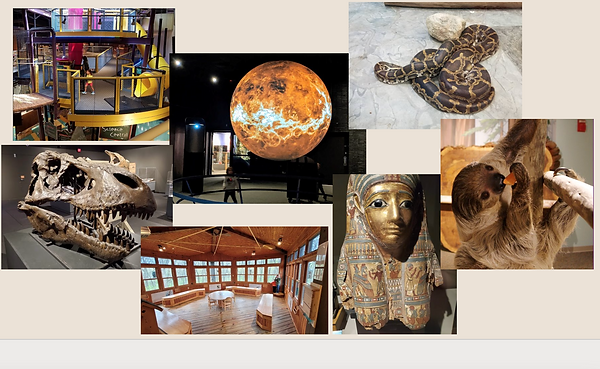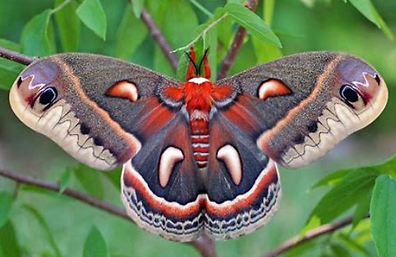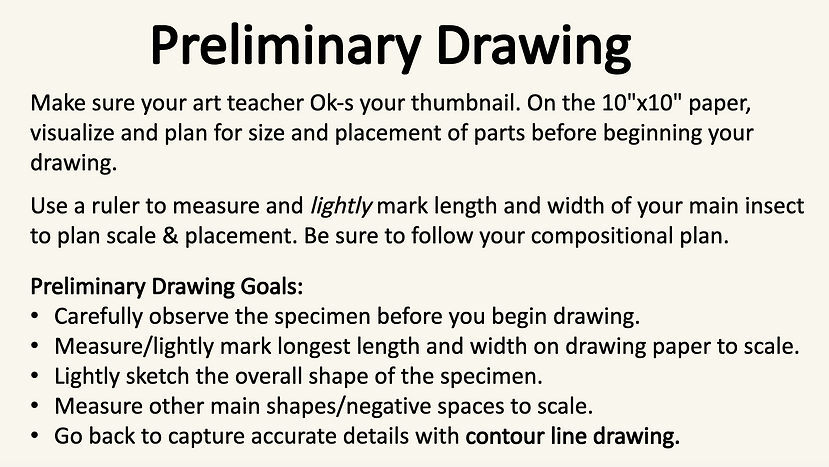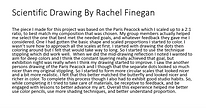Wednesday Nov 15

SEE - THINK - WONDER
Assignment: In your sketchbook, list as many observable things as you can about this image. Include any questions or things you wonder about the image.
What do you think about it?
Why do you think it was made?
Who do you think made it?
What do you like about it?
What do you wonder about it?
Wonder is what you don't know just by looking
at the visuals. What new questions come to mind?
What is Scientific Illustration?
Watch this video:
How can we use observational drawing to explore the field of Scientific Illustration and Entomology, while teaching others about ways insects support our environment?
In your sketchbook - title "Scientific Illustration" and write a definition in your own words.
DISCOVER
Collection Use & Care
DO NOT PICK UP: These are real insects that have been preserved. They are extremely fragile and will break. Do not hold it or carry it around.
GENTLY ROTATE OR NUDGE ONLY: With 1-2 fingers you may gently rotate, pull closer, or tip objects for better viewing. Be cautious and aware.
OBSERVE CLOSELY: Lean in. Arrange your body & sketchbook for clear observation. Feel free to use the magnifying cards.
Assignment: 5 minute study sketches
From your seat, choose one interesting insect specimen near you. Only one-two students should draw from the same object at a time.
Study sketches focus on the use of line to capture shape & form.
Study Sketch Goals:
-
Carefully observe the specimen before you begin drawing.
-
Quickly/lightly sketch the overall shape of the specimen.
-
Quickly/lightly sketch all other key parts.
-
Go back to capture accurate details with contour line drawing.
-
You may choose to add some shading, but accurate contour line drawing should be your focus.
-
Write the name given for the specimen under your sketch.

Your local Natural History Museum - what do you know?
Thursday Nov 16
The Dayton Society of Natural History (DSNH) operates the Boonshoft Museum of Discovery.
It has a collection of over 1.8 million natural history objects in the fields of biology, geology, anthropology and astronomy.
Their insect collection is their 4th largest collection, estimated at over 20,000 objects.
Some of their insects were preserved and donated by local community members. The Boonshoft archivist sent us this link if you if you would like to learn how to collect and preserve insects on your own.


Working with Insect Collections in Ohio

“By studying the visual aspects of a specimen and having the background of scientific studies, illustrators hold a unique place in the scientific community.
Artwork can help advance the fields of science by bringing new understanding to a subject and sharing this information with professionals and the public.”
From the Franklin Institute, Why We Need Scientific Illustration
Assignment: Continue 5 minute study sketches
From your seat, choose one interesting insect specimen near you. Only one-two students should draw from the same object at a time.
Study sketches focus on the use of line to capture shape & form.
Study Sketch Goals:
-
Carefully observe the specimen before you begin drawing.
-
Quickly/lightly sketch the overall shape of the specimen.
-
Quickly/lightly sketch all other key parts.
-
Go back to capture accurate details with contour line drawing.
-
You may choose to add some shading, but accurate contour line drawing should be your focus.
-
Write the name given for the specimen under your sketch.
Friday Nov 17
How can drawing help us understand and convey information?
Drawing is a form of analysis.
Diagrams are a type of illustration that can be used to study & understand the natural world.
Entemology



Graphite Transfer + Labeling

Be sure this image stays in your sketchbook.
We will return to this exercise to practice color pencil blending and shading techniques. Keep it safe.
Monday Nov 27
Assignment: Transfer this diagram to your sketchbook and label the parts as shown in the illustration.
Visit this link for video instructions on graphite transfer.
1. Flip the photocopy over. Apply heavy graphite to all lines of the image. Tip: place a blank white sheet under your image for better contrast.
2. Next place the image, graphite scribble side down, on the next page of your sketchbook. Center the image on your sketchbook page.
3. Carefully draw over the lines on the front of the photocopy beetle page. Your lines will transfer to your sketchbook.
4. The tiger beetle has the most common attributes of insects. Label the parts of this beetle to remember insect parts and assist your observation skills to “see” the component parts of the specimen you will illustrate.
Analyze Thumbnail Studies and Choose your Subject
-
We have many amazing insect specimens from the Boonshoft Museum. However, in order to support concentrated study, only one student may draw an individual specimen at a time.
Assignment: Choose your top two preferences for subjects for your color pencil illustration.
-
1. Carefully analyze your thumbnail sketches. Consider your favorite, most effectively drawn.
-
2. Insect gallery walk - Place your name on a sticky note next to the insect and write the number for your 1st and 2nd choices.
-
Example. Jenny M - 1 -C Jenny M – 2 -D
Assignment: View this PowerPoint, take notes and complete the color wheel in your sketchbook.
Insect Identification: https://bugguide.net/node/view/55
What can we discover about our insect to share with others?
Assignment: Research and record the following information in your sketchbook
-
the scientific and common name of your insect.
-
A claim to fame
-
4-5 interesting facts (life cycle, habits, migration, etc)
Color Pencil Techniques
Wednesday Nov 29


How can we create an interesting composition?
Thursday Nov 30
Assignment: Analyze the following compositions in your sketchbook:

Assignment: Make 2 thumbnail sketches in your sketchbook to visualize
and plan a strong composition for your illustration.
You will be working in a square format.
Each thumbnail should be 4" x 4" .
Determine what part you might want to enlarge for closer study
and include a circle to illustrate that.
Include where you will have text conveying the scientific and common name of your insect.

How will we communicate scale?
When a drawing is described as ‘to scale’, it means that each element in the drawing is in the same proportion, related to the real or proposed object.
A scale drawing is smaller or larger than the real-life object by a consistent ratio (or percentage). Indicated by a ratio.


What makes a successful scientific drawing?
Assignment: Set goals for your illustrations to create a rubric.
What do we want to strive for in our illustrations in terms of :
-
Composition
-
Illustration (drawing techniques)
-
Media (colored pencil techniques)
-
Information
-
Craftsmanship
-
Other?
Assignment: Create a preliminary drawing following these guidelines: (No shading!)

Tuesday Dec 5

-
Measure and mark LIGHTLY exterior points
-
Lightly sketch main shapes of specimen
-
Measure and check shapes for accuracy and proportion
-
When all main shapes are in place and checked for accuracy move on to refining contours - edges and interior details
-
No shading! Color comes later to show form and texture.
-
Save space for Scientific + Common Name but don't write them in yet - there will be a lesson on lettering later.
-
Save space for detail/ magnified drawing.
Assignment: Round 1 Critique (See Austins butterfly PPT under Project Resources) Photograph your drawing at this point and document feedback and changes for final reflection artifact)
Assignment: Watch this video and practice shading the beetle you copied into your sketchbook. We will use the sampler for our final drawings.
Assignment: Create a sampler practice color grid as follows and utilize it during your final drawing to experiment with the colors, patterns and textures found on the tiger beetle.

Assignment: Utilize shading and blending techniques you have learned to create a scientifically accurate color pencil drawing of your insect. Include a close-up view.


Assignment: Utilize the following conventions to neatly label your illustration.

Handout with boxes
Handout no boxes
General Project Resources
Austin's Butterfly Critique Process
-
Several websites dedicated to insect identification. Some work by having you describe and match identifying characteristics.
https://www.insectidentification.org/bugfinder-start.php
https://bugguide.net/node/view/15740
-
Google Lens and your phone camera (not Google Chrome)
Use it to look up the image you photograph and it should return several websites that you can use to begin to identify your specimen. (You may need to use clues from these sights for additional searches to find both the common and scientific name)
Reflect + Share


Slide 1 Insert a photograph of your drawing
Photograph it on the easel with black background and change your slide background to black.
Slide 2 is your Reflection
Title: Scientific Illustration
Refer to the rubric and your mid drawing reflection.
Write a reflection (in paragraph form) describing how you addressed the following points on the rubric - utilize appropriate terminology-
Thesis statement of growth: Start with a thesis statement of growth. "My greatest area of growth in this project was..."
Evidence of Growth - What goals did you set for yourself in this project (refer to your sketchbook) and how did you progress toward meeting those goals and the those on the rubric? (Refer to your mid drawing reflection and consider feedback you received during critiques)
Skills + Techniques -What were some new skills or techniques you learned and applied to make your drawing more successful in terms of the following and what skills did you apply and build on that you learned previously in the year: (refer to the elements and principles of design as you think and write - you can also refer to the shared rubric we created)
-
Composition / Layout
-
Scaling
-
Development of the drawing (contour line/basic shapes, to blending and layering color for more accurate details and texture, developing form through shading
techniques (hatching, stippling, tonal shading etc.)
-
Craftsmanship
Summary statement- Refer back to original thesis statement of growth. "In conclusion..."
-
Write your Name
POST YOUR POWERPOINT TO THIS PADLET MAKE SURE YOUR NAME IS ON IT!
https://padlet.com/jennymontgomery/scientific-illustration-2023-r84f6wrqrxc5mzk8
Continued Practice
Layering + Blending Color







